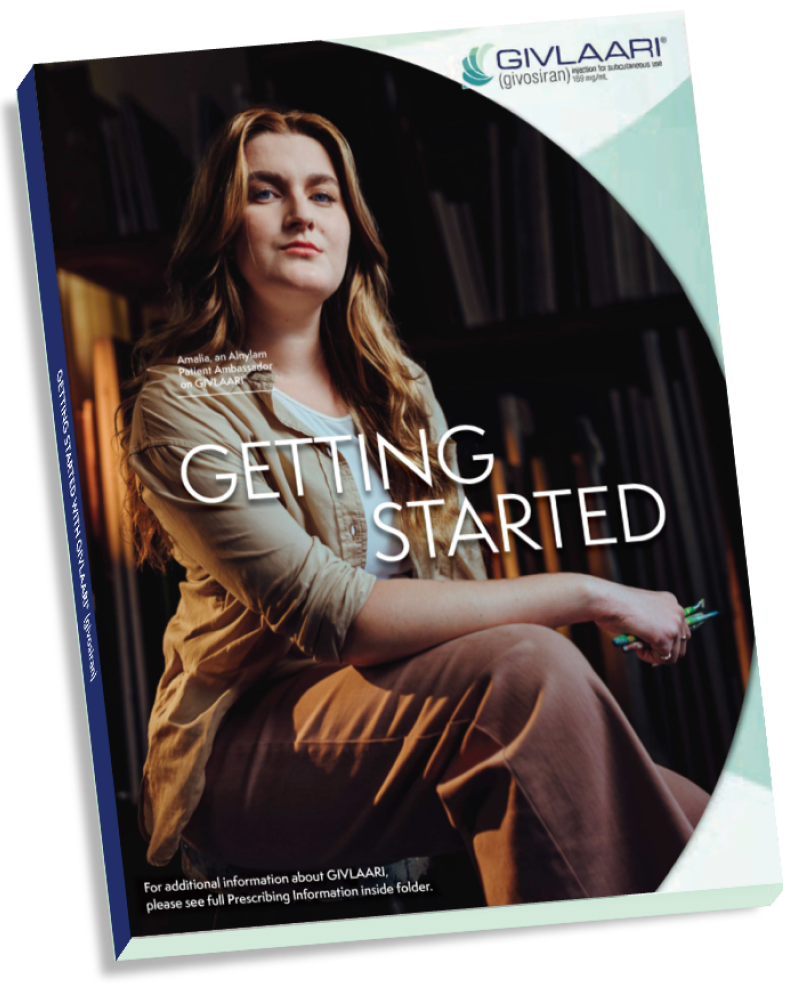
Patient Experience
Help your patients rediscover their everyday
Acute hepatic porphyria (AHP) causes severe and debilitating attacks that can disrupt and overwhelm the lives of patients with the disease. GIVLAARI® (givosiran) may help reduce AHP attacks in adults.1,2
Mike and Amalia are real patients diagnosed with AHP and taking GIVLAARI. Amalia is an Alnylam Patient Ambassador taking GIVLAARI. Explore their profiles and discover their unique journeys with the disease. Below, you will also find helpful resources for your patients who are considering treatment with GIVLAARI.


Mike’s Journey
"I would describe porphyria as a thief. It has taken everything from me."
Mike is a working father of two whose long battle and eventual diagnosis with acute intermittent porphyria (AIP) changed the trajectory of his life.


History with AHP
Pre-diagnosis
- Began having mild attacks that became significantly more aggressive over time
- Attacks initially felt like heartburn and progressed into severe abdominal pain
- Cholecystectomy performed
- Tested for Crohn's disease and appendicitis
- Misdiagnosed with prostatitis and an intestinal infection
- Labeled as "drug seeking" at the pain clinic
Post-diagnosis
- Diagnosed with AIP 4 years after first attack
- Visited ER every 3-6 weeks due to attacks
- Prescription pain medications
Life with AHP Today
Treatment
- GIVLAARI – Once-monthly subcutaneous injection2
Day-to-day living with AIP
- Experienced a reduction in attacks
- Monitors/avoids common attack triggers (alcohol, smoking, certain medications, etc)3,4
- Has occasional fatigue while traveling
Individual results may vary.
"Now that I'm experiencing fewer attacks, I'm not afraid to go out." –Mike


Amalia's Journey
"Your pain is real; it is valid, and you don’t have to go through it alone."
Amalia had a lot of goals and ambitions as she started her freshman year of college. A year later, she was diagnosed with acute intermittent porphyria (AIP) and had to put her dream of helping others on hold to focus on her health.


History with AHP
Pre-diagnosis
- Experienced childhood allergies to certain foods and materials
- Began having mild attacks that became significantly more aggressive over time
- Attacks initially felt like nausea and progressed into severe abdominal pain
- Visited emergency room several times without receiving any diagnosis
- Tested for appendix and gallbladder issues
- Was refused pain medication by emergency room
Post-diagnosis
- Diagnosed with AIP after finding out it was genetic
- Avoided managing disease until attacks became too severe
- Started seeing therapist due to anxiety
- Visited hospital every month for cyclical attacks
Life with AHP Today
Treatment
- GIVLAARI – Once-monthly subcutaneous injection2
Day-to-day living with AIP
- Experienced a reduction in attacks
- Monitors/avoids common attack triggers (alcohol, smoking, certain medications, etc)3,4
- Has occasional fatigue and nausea during menstrual cycle
Individual results may vary.
"The reason I stay on GIVLAARI is because with fewer attacks, I feel like I have more control back in my life. I’m able to make plans for the future." –Amalia
Resources for your patients
Alnylam is committed to providing disease and product information to patients considering or currently taking GIVLAARI. Learn how your patients can get access to educational resources.
![]()
Connect your patients with Alnylam Assist® for patient support services
Alnylam Assist® can help your patients throughout treatment with GIVLAARI:
Materials to help your patients along the way
The Patient Welcome Kit provides a number of helpful resources for your patients who are getting started on GIVLAARI:
Starting Your Journey Brochure – A guide to starting treatment with GIVLAARI
GIVLAARI Treatment Journal – For patients to keep handy as they continue treatment. It can help them keep track of important milestones and learn about ways to potentially manage side effects with their doctor
Alnylam Assist® Brochure – Helps patients get access to GIVLAARI and describes patient support services
Notebook & Pen – For patients to track their treatment journey
Answer your patients' frequently asked questions
Your patients may have questions about treatment with GIVLAARI. Get answers to common questions that patients may ask when considering or taking GIVLAARI.
Do you have more questions about GIVLAARI?
Schedule an informative discussion with a GIVLAARI Representative.
Contact a RepresentativeReferences: 1. Anderson KE, Bloomer JR, Bonkovsky HL, et al. Ann Intern Med. 2005;142:439-451. 2. GIVLAARI [prescribing information]. Cambridge, MA: Alnylam Pharmaceuticals, Inc. 3. Balwani M, Wang B, Anderson KE, et al; Porphyrias Consortium of the Rare Diseases Clinical Research Network. Hepatology. 2017;66:1314-1322. 4. Lin CS-Y, Lee M-J, Park SB, Kiernan MC. Clin Neurophysiol. 2011;122:2336-2344.

